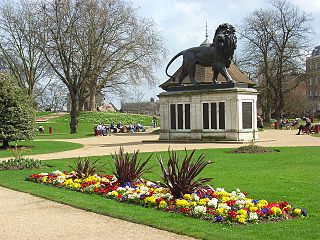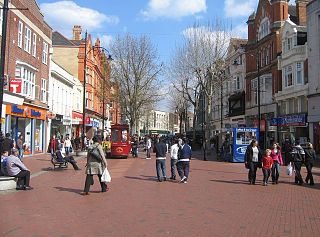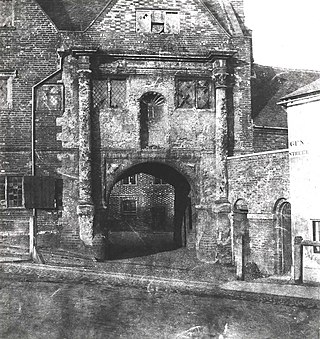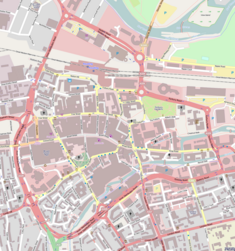
Reading is a market town and borough in Berkshire, England. Located in the Thames Valley at the confluence of the rivers Thames and Kennet. Reading is 40 miles (64 km) east of Swindon, 24 miles (39 km) south of Oxford, 40 miles (64 km) west of London and 16 miles (26 km) north of Basingstoke.

Reading Abbey is a large, ruined abbey in the centre of the town of Reading, in the English county of Berkshire. It was founded by Henry I in 1121 "for the salvation of my soul, and the souls of King William, my father, and of King William, my brother, and Queen Maud, my wife, and all my ancestors and successors." In its heyday the abbey was one of Europe's largest royal monasteries. The traditions of the Abbey are continued today by the neighbouring St James's Church, which is partly built using stones of the Abbey ruins.

Reading School is a grammar school for boys with academy status in the English town of Reading, the county of Berkshire. It traces its history back to the school of Reading Abbey and is, thus, one of the oldest schools in England. There are no tuition fees for day pupils, and boarders only pay for food and lodging. Reading is one of the best state schools in the UK according to the GCSE and A-level tables and has consistently ranked in the top ten.

Kendrick School is a selective girls' grammar school situated in the centre of Reading, Berkshire, UK. In February 2011, Kendrick became an Academy.

Forbury Gardens is a public park in the town of Reading in the English county of Berkshire. The park is on the site of the outer court of Reading Abbey, which was in front of the Abbey Church. The site was formerly known as the Forbury, and one of the roads flanking the current gardens is still known as The Forbury. Fairs were held on the site three times a year until the 19th century.

Greyfriars Church is an evangelical Anglican church, and former Franciscan friary, in the town centre of Reading in the English county of Berkshire. The church forms part of the Church of England's Diocese of Oxford.

St Laurence's Church is a Church of England mission and former parish church in the town of Reading in the English county of Berkshire. It is situated alongside the site of Reading Abbey, formerly bounded by the main Compter Gate to the south and the Hospitium of St John to the north. What was once the private chapel of the latter institution still remains in the north aisle. The church is a Grade I listed building.

Reading Civic Centre was a civic centre in the town of Reading, itself in the English county of Berkshire. The centre dated from the mid-1970s.

Broad Street is a main pedestrianised thoroughfare and the primary high street in the English town of Reading. The street is situated in the town centre, running for approximately 0.25 miles (0.40 km), from west to east. The western end of the road lies at the crossroads with Oxford Road, West Street and St Mary's Butts. The eastern end continues as King Street after the junction with Minster Street and Butter Market.

Watlington House is a 17th-century building, with a large walled garden, in the town of Reading in the English county of Berkshire. The building is brick built and is reputed to be the oldest surviving secular building in the town. It is a listed building, being listed grade II*. The information on the Historic England website is https://historicengland.org.uk/listing/the-list/list-entry/1321898

Reading Town Hall is the town hall of Reading, Berkshire, England. The town hall was built in several phases between 1786 and 1897, although the principal facade was designed by Alfred Waterhouse in 1875. Situated close to the site of Reading Abbey, it is adjoined to the north by the Hospitium of St John and to the south by St Laurence's Church.

The Abbey Gateway was originally the inner gateway of Reading Abbey, which today is a large, mostly ruined abbey in the center of the town of Reading, in the English county of Berkshire. The gateway adjoins Reading Crown Court and Forbury Gardens and is one of only two abbey buildings that have survived intact, the other being the Hospitium of St John the Baptist. It is a grade I listed building, and includes a porters lodge on the ground floor and a large open room above the gate.

Friar Street is a thoroughfare in the English town of Reading. It runs parallel to Broad Street, connected by Union Street, Queen Victoria Street and Cross Street. At the western end is the Greyfriars Church and at the eastern end are the Town Hall and St Laurence's Church.

The Oracle was a workhouse that produced cloth in the English town of Reading, Berkshire. The Oracle shopping centre, which now occupies a small part of the site, takes its name from the Oracle workhouse.

The George Hotel is a hotel and former coaching inn in the town of Reading in the English county of Berkshire. It is situated in the eastern end of the town centre, on the corner of King Street and Minster Street, next to The Oracle shopping mall. It is a Grade II listed building.

High Bridge, sometimes known as Duke Street Bridge, is a bridge across the River Kennet in the town centre of Reading in the English county of Berkshire. It links Duke Street, to its north, and London Street, to its south. High Bridge is the oldest surviving bridge across the Kennet, and is a grade II listed building. It comprises a single arch of vermiculated Portland stone, with a plain keystone of ashlar.
Occupation at the site of Reading may date back to the Roman period, possibly as either a trading port on the River Thames, or as an intersection on the Roman road connecting London with Calleva Atrebatum near Silchester.
Adam de Lathbury, O.S.B., otherwise known as Adam of Lathbury or Adam Lothbury, was a Benedictine monk who ruled as Abbot of Reading Abbey, in the English county of Berkshire, from 1226 to 1238.

The following is a timeline of the history of Reading, the county town of Berkshire in England.
Samuel Watlington was a cloth merchant and leading citizen of the town of Reading in the English county of Berkshire. He held the office of Mayor of Reading in 1695 and 1711. In 1688, he and his wife Anne had Watlington House, reputed to be the oldest surviving secular building in Reading, built.





















